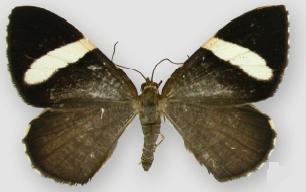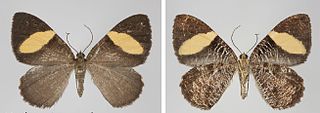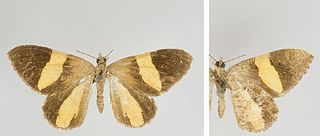
Hagnagora is a genus of moths in the family Geometridae erected by Herbert Druce in 1885.

Hagnagora elianne is a species of moth of the family Geometridae first described by J. Bolling Sullivan in 2011. It is found in Costa Rica and Honduras.

Hagnagora unnia is a species of moth of the family Geometridae first described by J. Bolling Sullivan in 2011. It is found in Costa Rica.

Hagnagora buckleyi is a species of moth of the family Geometridae first described by Herbert Druce in 1885. It is found in north-western Ecuador. It is named for the botanist Samuel Botsford Buckley.

Hagnagora catagrammina is a species of moth of the family Geometridae first described by Herbert Druce in 1885. It is found in Central America, from Nicaragua to Panama.

Hagnagora lex is a species of moth of the family Geometridae first described by Herbert Druce in 1885. It is found in the eastern Ecuadorian Andes.

Hagnagora marionae is a species of moth of the family Geometridae first described by Gunnar Brehm and J. Bolling Sullivan in 2005. It has been collected only at two high mountain areas in Costa Rica at elevations above 2,500 metres (8,200 ft).

Hagnagora richardi is a species of moth of the family Geometridae first described by Gunnar Brehm in 2015. It is only known from a small region around Podocarpus National Park in Zamora-Chinchipe and Loja provinces in Ecuador.

Hagnagora clustimena is a species of moth of the family Geometridae first described by Herbert Druce in 1893. It is found in Mexico, Panama, Honduras and Costa Rica.

Hagnagora mirandahenrichae is a species of moth of the family Geometridae first described by Gunnar Brehm in 2015. It is only known from the sectors Santa Maria and Pitilla from Área de Conservación Guanacaste, Guanacaste Province, in north-western Costa Rica.

Hagnagora mortipax is a species of moth of the family Geometridae first described by Arthur Gardiner Butler in 1872. It is found in Costa Rica and Ecuador.

Hagnagora jamaicensis is a species of moth of the family Geometridae first described by William Schaus in 1901. It is found on Jamaica.
Hagnagora acothysta is a species of moth of the family Geometridae first described by William Schaus in 1901. It is found in Brazil.
Hagnagora guatica is a species of moth of the family Geometridae first described by William Schaus in 1927. It is found in Guatemala.

Hagnagora ephestris is a species of moth of the family Geometridae. It is found in Colombia.

Hagnagora discordata is a species of moth of the family Geometridae first described by Achille Guenée in 1858. Although the type locality is Chile, the species is not thought to be found there. It has been recorded from Santa Catarina in Brazil.

Hagnagora luteoradiata is a species of moth of the family Geometridae first described by Paul Thierry-Mieg in 1892. It is found from Costa Rica to Ecuador.

Hagnagora subrosea is a species of moth of the family Geometridae first described by William Warren in 1909. It is found in Peru.

"Hagnagora" mesenata is a species of moth of the family Geometridae first described by Felder and Rogenhofer in 1875. It is found in Chile.

"Hagnagora" vittata is a species of moth of the family Geometridae first described by Rodolfo Amando Philippi in 1859. It is found in Chile.















